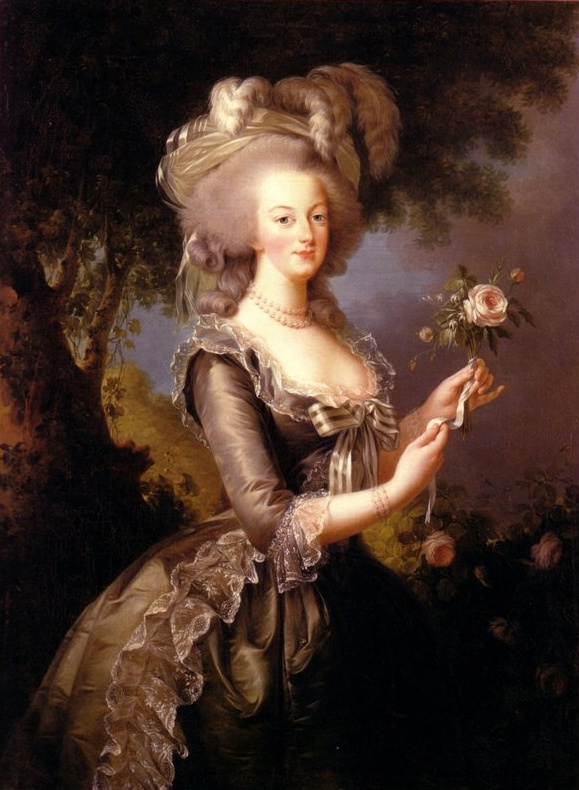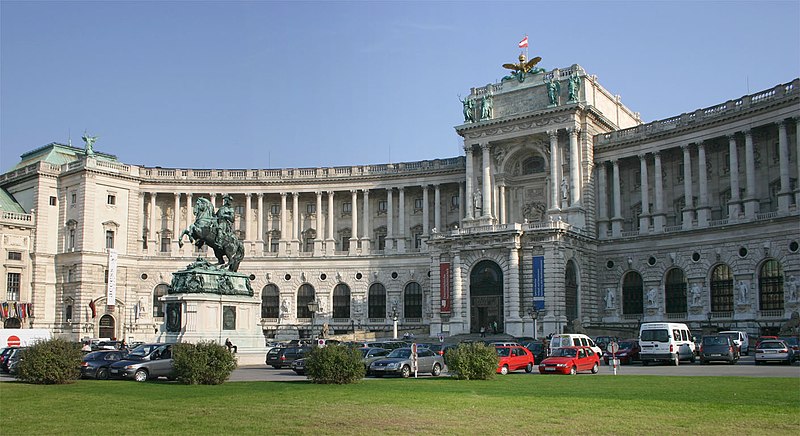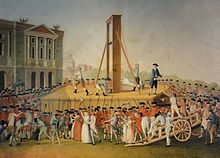
Above: Marie Antoinette, 1783.
On this day in history, 16 October 1793, the thirty-eight year old Marie Antoinette, former Archduchess of Austria and more famously queen of France as consort of Louis XVI, was executed during the bloody and brutal French Revolution then ravaging the country. In Simon Sebag Montefiore, Marie Antoinette was 'a woman more sinned against than sinning'. But Eric Konigssberg intriguingly argues that 'the image of Marie Antoinette - dauphine, villain, tea-party thrower in shepherdess garb - is in the midst of an extreme rehab', and she holds a central and fascinating place in popular culture. Her life was compelling, extraordinary, and ultimately, highly tragic. She in no way deserved her fate, for what crime did she actually commit? In Marie Antoinette's case, it was a brutal but tragic fact that she was, put simply, in the wrong place at the wrong time.
Many misconceptions and scandals still attach themselves to the French queen's name, most famously the nonsensical rumour that she coldly claimed in regards to starving peasants: "Let them eat cake". It is perhaps more worthwhile to consider the facts of her life rather than the sensational dramas. Born on 2 November 1755 to the Holy Roman Emperor Francis I and his formidable wife Maria Theresa, empress, she was the fifteenth child of this illustrious union and, from the very first, would have been very well aware of her worth in European dynastic politics.

Above: Hofburg Palace in Vienna, Austria; the glamorous palace where Marie Antoinette was born.
Marie Antoinette appears to have enjoyed not only a luxurious but also a protective and peaceful childhood surrounded by her many sisters, with whom she was close, especially Maria Carolina; although Marie Antoinette regarded her mother in awe perhaps even fear. As Antonia Fraser suggests, however, she was probably not academic, and was not noted for her linguistic capabilities in a country in which French, German, and Italian were commonly spoken. She appears though to have had some natural talent in regards to art, and was musically gifted, playing the harpsichord, spinet, harp and clavichord. Her beauty and grace were commended by visitors.
In May 1770, the fourteen-year old Marie Antoinette married the Dauphin of France, Louis, in the Palace of Versailles, although famously the marriage was not consummated, and would not be for several anxious years. At this point, Marie Antoinette due to her beauty and graceful nature was popular with her new subjects. Her portraits at this stage depict a youthful, charming, sweet young girl blossoming within her new country.

Above: Marie Antoinette, aged 13.
But the prevailing tensions between Austria and France rendered the marriage unpopular among courtiers, who resented the alliance, and which was to become increasingly unpopular during the coming years. Marie Antoinette's unorthodox dislike of court protocol rendered her open to ridicule. Her relationships were also unpopular, particularly with women such as the duchesse de Polignac, which was later sensationalised and distorted into a supposed lesbian affair.
Her failure, in the early years of her marriage as Queen of France, to become pregnant, while other royal women such as the comtesse d'Artois were able to bear sons, exposed Marie Antoinette to doubt, anxiety, and ridicule. Satirical pamphlets were published which criticised the king's alleged impotence and claimed that the queen was a whore who sought sexual fulfilment elsewhere with both men and women. This cruelty and anxiety led Marie Antoinette to spend lavishly on fashion, expanding her wardrobe and becoming something of an icon, while earning a reputation as a party-loving queen, renovating the Petit Trianon which soon became associated with her alleged extravagance. Finally, however, in 1778 the queen fell pregnant, and gave birth to her first daughter in December. Still the need for a male heir continued.
In 1781, the twenty-six year old queen finally bore a son, Louis Joseph Xavier Francois. Despite this celebratory event, Marie Antoinette remained uninvolved in political affairs, although she continued to be blamed for allegedly subjecting France to the authority of her home country, Austria. As a result, she began to take an increasingly active role in the upbringing of her children, and in 1785 gave birth to a second son, Louis Charles. The baby was rumoured to be illegitimate, the child of a sordid union between the queen and her favourite, Fersen. By then, the queen's unpopular image among her subjects was rapidly worsening.

Above: state portrait of Marie Antoinette and her children, 1787.
The worsening financial situation in France forced the calling of the Assembly of Notables after a hiatus of 160 years, although it served little good, instead defying the king. At this stage Marie Antoinette became more closely involved in politics, especially on her children's behalf as they grew older. She actively created an image of herself, as preserved in the 1787 painting above, as a caring and dutiful mother. Later, the seven-year old Dauphin died, a tragic and devastating affair which broke the queen's heart, although her subjects were not particularly sympathetic as they grew increasingly bloodthirsty and resentful.
As the National Assembly demanded more rights, the monarchy slowly but surely became more undermined as an institution due to the king's incompetence and the queen's unpopularity amongst her subjects. As the French Revolution evolved, the royal family's position became greatly dangerous, particularly with the advent of the Declaration of the Rights of Man and of the Citizen. Their friends, including the comte d'Artois and the duchesse de Polignac, escaped abroad due to fear of assassination. Marie Antoinette continued to be harshly and hostilely criticised in satirical pamphlets, which claimed that she was involved in love affairs with the marquis de La Fayette. The worst of the pamphlets suggested that she had even slept with her own son. Clearly, a cruel and untruthful image was being created of the queen, attacking her through her gender, sexuality and political position. There was no credence to any of these spiteful rumours.
Summarising these complex events in brief, Louis was executed in January 1793, although not without dissent and controversy. How this personally affected his wife can only be imagined, but the last scene between husband, wife and children was poignant and tragic. Marie Antoinette's unpopularity had severely worsened with the declaration of war with Austria the preceding year; her status as enemy of the country was now clear to her subjects as never before. She was imprisoned in August 1793 following her incarceration in the Tower. On 14 October, she was tried by the Revolutionary Tribunal, and was accused of the vilest and most untrue of crimes: orchestrating Versailles orgies, sexually abusing her son, declaring her son to be the new king of France following her husband's execution, sending millions of livre money to Austria, and orchestrating the massacre of the Swiss Guards the previous year. Nonetheless, she remained dignified and answered the charges related to her, but to no avail. She was declared guilty and sentenced to death.

Above: Marie Antoinette's execution, 16 October 1793.
Her hair having been cut off, the former French queen was publicly driven through Paris in an open cart to the execution site, and at 12.15pm, aged thirty-eight, she was guillotined at the Place de la Concorde (Revolution), just one of thousands of innocent victims brutally slaughtered during the Revolution. Dressed in white, Marie Antoinette's outfit made, in the words of Gareth Russell, 'a dazzlingly significant statement to those who had come to watch her die'. Her kindness, charity and goodwill were remembered and immortalised by those loyal to her cause, while others continued to slander her and belittle her after her death. She remains a contentious and controversial figure in modern society today, associated with extravagance, luxury, the ill-fate of rule, the French Revolution, fashion, to name but a few. Maxime de la Rocheterie fittingly wrote of her:
'She was not a guilty woman, neither was she a saint; she was an upright, charming woman, a little frivolous, somewhat impulsive, but always pure; she was a queen, at times ardent in her fancies for her favourites and thoughtless in her policy, but proud and full of energy; a thorough woman in her winsome ways and tenderness of heart...'
RIP Marie Antoinette. She deserved better than the cruel, bloody fate she met reservedly and calmly on that warm October day, deserted by her subjects, lost to her husband, separated from her children. Although she may not have been the most effective queen of France, the appalling political and social circumstances which were in place during her rule condemned any attempts she made at being a good queen. We should remember her with fairness, honesty, and integrity. She deserved understanding and compassion not afforded by her resentful subjects during an ill-fated, and ultimately tragic, reign as queen of France.
I believe in all honesty both she and Louie 16th were wrongly accused and tried. This tragedy should never have fallen upon them.
ReplyDeleteI agree! Neither Marie Antoinette nor her husband and their child deserved such a cruel and utterly humilliating fate. If anything, Marie Antoinette over the years has gained my sympathy and empathy. Noteworthy are three things (1) she was a caring and loving mother, (2) stood by her husband, loyally, through the end, (3) her last words to her executioner, when she stepped on him accidentally, "I am sorry, Sir, I did not mean to do it", are so moving! Worthy of a Queen!
ReplyDeleteShe was accused of treason, and from the revolutionaries point of view, she was guilty. She had been corresponding with france's enemies in the hope of getting the revolution overturned. of course, she didn't see it like that.
ReplyDeleteAs usual an interesting article :) But I think you made a typo here:
ReplyDeleteBorn on 2 November 1775 to the Holy Roman Emperor Francis I and his formidable wife Maria Theresa, empress, she was the fifteenth child of this illustrious union
She was born in 1755 (as I know that you know, it's so easy to press the wrong key), not 1775 :)
Hi, please notice this site - Execution of Marie-Antoinette. French Revolution History.
ReplyDeleteThank you - Regards Karla